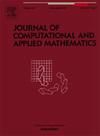rayleigh - bassaard问题的隐式Schwarz域分解方法
IF 2.1
2区 数学
Q1 MATHEMATICS, APPLIED
Journal of Computational and Applied Mathematics
Pub Date : 2025-04-28
DOI:10.1016/j.cam.2025.116718
引用次数: 0
摘要
介绍了一种求解rayleigh - bassariard对流问题的隐式Schwarz域分解(SDD)方法。这项工作背后的动机是开发一种替代算法,消除交替施瓦茨域分解方法中观察到的停滞误差,同时增强跨子域接口的信息传输。探索的一个关键问题是隐式SDD方法是否与交替方法相媲美,以及它是否在效率和准确性方面提供了真正的改进。研究重点是建立隐式SDD方法结合Legendre搭配的收敛性的理论证明,保证其适用于rayleigh - bassanard问题。此外,还努力优化计算成本,使算法更适用于大规模模拟。对该方法进行了数值验证,以评估其性能并确认其优点。与交替方法不同,交替方法需要在每个时间步长求解多个系统,隐式方法求解单个系统,潜在地提高了收敛速度。理论分析和数值实验表明,该方法有效地提高了精度,减少了计算量,特别是在不对称区域分解的情况下。本文章由计算机程序翻译,如有差异,请以英文原文为准。
Implicit Schwarz domain decomposition method for a Rayleigh–Bénard problem
This paper introduces an implicit Schwarz domain decomposition (SDD) method for solving the Rayleigh–Bénard convection problem. The motivation behind this work is to develop an alternative algorithm that eliminates the stagnation error observed in the alternating Schwarz domain decomposition method while enhancing information transmission across subdomain interfaces. A key question explored is whether the implicit SDD method is comparable to the alternating approach and whether it provides a real improvement in terms of efficiency and accuracy. The study focuses on establishing a theoretical proof of convergence for the implicit SDD method combined with Legendre collocation, ensuring its suitability for the Rayleigh–Bénard problem. Additionally, efforts are made to optimize computational cost, making the algorithm more practical for large-scale simulations. Numerical validation is carried out to assess its performance and confirm its advantages. Unlike the alternating approach, which requires solving multiple systems per time step, the implicit method solves a single system, potentially improving convergence speed. Theoretical analysis and numerical experiments demonstrate that this approach effectively improves the accuracy and reduces computational effort, particularly in the case of asymmetric domain decompositions.
求助全文
通过发布文献求助,成功后即可免费获取论文全文。
去求助
来源期刊
CiteScore
5.40
自引率
4.20%
发文量
437
审稿时长
3.0 months
期刊介绍:
The Journal of Computational and Applied Mathematics publishes original papers of high scientific value in all areas of computational and applied mathematics. The main interest of the Journal is in papers that describe and analyze new computational techniques for solving scientific or engineering problems. Also the improved analysis, including the effectiveness and applicability, of existing methods and algorithms is of importance. The computational efficiency (e.g. the convergence, stability, accuracy, ...) should be proved and illustrated by nontrivial numerical examples. Papers describing only variants of existing methods, without adding significant new computational properties are not of interest.
The audience consists of: applied mathematicians, numerical analysts, computational scientists and engineers.

 求助内容:
求助内容: 应助结果提醒方式:
应助结果提醒方式:


